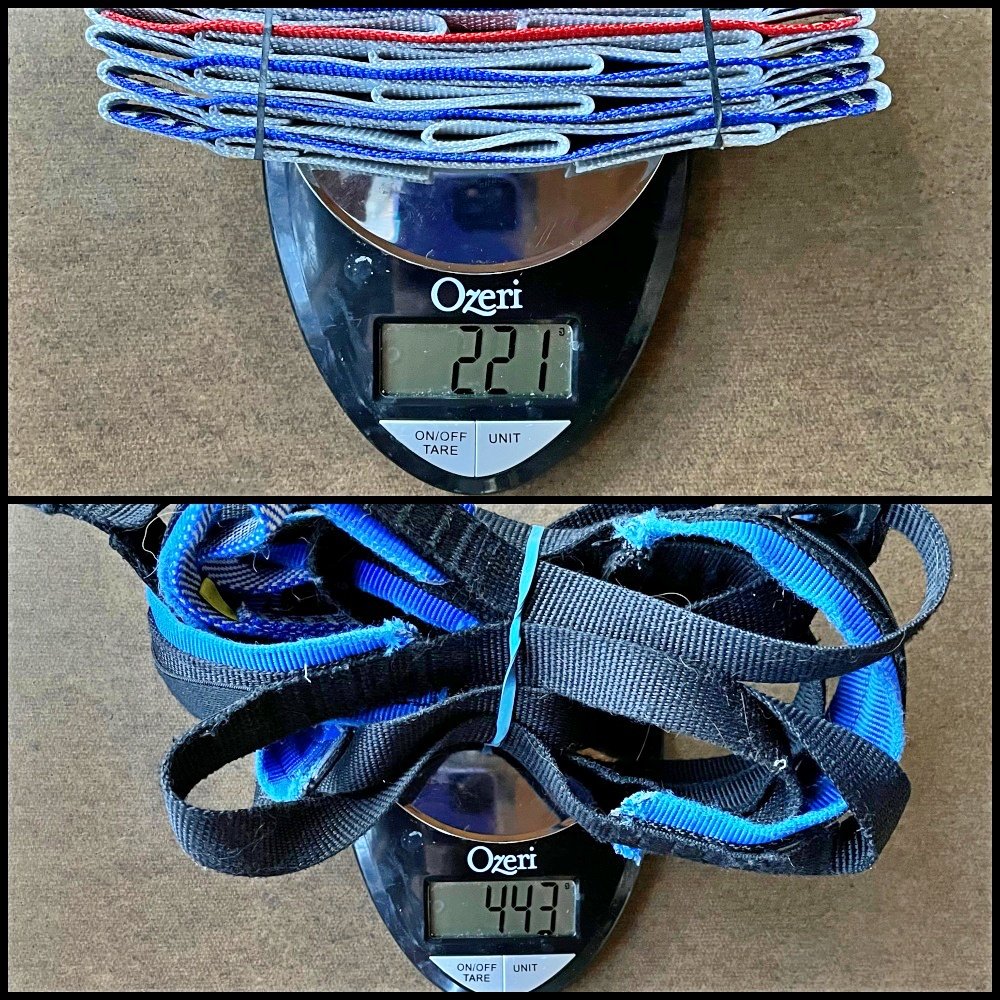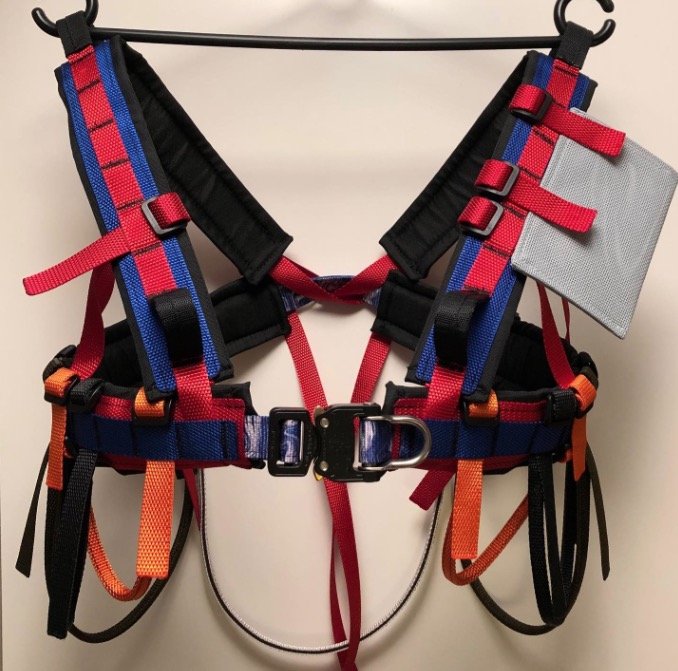Aideer climbing big wall gear - handmade in Sweden
One of the most iconic legends in big wall climbing is Yvon Chouinard, hand crafting pitons in his metal shop and selling them to other climbers in the early days of Yosemite. The spirit of creativity and craftsmanship still lives on with various small scale manufacturers.
Here's one to check out: Sweden’s Olle Hjort of Aideer Climbing big wall gear. Olle sews high quality, well designed, and yes, colorful gear for your next big wall adventure. Olle was kind enough to send me a pair of ladders and adjustable fifi for review, and they are schweeeeet! (In the rare cases I’m offered gear for a review like this, I’ll always tell you about it upfront.)
Connect with Olle on Instagram (preferred), email, or website.
Currently, Aideer offers the following products:
ladders (let’s not call them “etriers” - French for “stirrup” - anymore, okay?)
Russian aiders (VERY cool, more on those below)
adjustable tether/daisy
adjustable fifi
big wall gear sling
prototyping a portaledge (currently being tested in Patagonia, production should start soon.)
Olle has a website, but he prefers that people contact him for current pricing and order through his Instagram. You can customize length and colors of many products, message him for details.
Prices are in Swedish kronor (SEK). (As I write this in winter 2022, the exchange rate is about 10 SEK to 1 USD.) Pricing on his gear is very competitive. Shipping costs to USA are 200 SEK (about $20 USD) for 1 kg, say a pair of Aideers and an Adjustable Fifi.
Aideer ladders
Let's check out those ladders, a key piece of big wall gear. I’ve used the Yates ladders for pretty much forever, and been quite happy with them. However, while they are certainly durable, the Yates ladders always felt a little clunky. The first thing I noticed when I picked up the Aideer ladders: these things are LIGHT! I got out the scale and discovered they are literally HALF of the weight of my Yates ladders, 221 grams compared to 443, wowzer!
Lightweight does not mean less durable. The Aideer ladders trim some weight in clever places, like using a strip of fiberglass to stiffen the top step. They are reinforced with 1 inch tubular webbing around the top of triangle, which is going to take the most beating, and the quality of the sewing is impeccable.
My Yates ladders seem to easily get a twist in the bottom step or two, a minor rock in my shoe to deal with. The few times I've been out testing the Aideer ladders, they never seem to get a twist.
In terms of dimensions, they are pretty comparable to the Yates: six steps, with the third step down being a different color to remind you to get in ASAP. Speaking of colors, you might be able to ask for something custom. I didn't, and Olle sent me ladders with red white and blue, three of my favorite colors. =^)
The Aider ladders do not have an elastic band under the 4th and 5th steps like the Yates, which some climbers (like big wall ace Kevin DeWeese @failfalling) find convenient for leg hauling. (Olle said you can add a thin bit of elastic cord yourself if you want this feature.) Kevin also mentioned to me that the narrow steps of the Aideer are slightly more tiring for the arch of your foot on very long routes. He writes: “All in all my Aideers are my go to for in a days and pushes and my Yates speed walls are my go to for vertical camping trips.”
Overall, I’m super happy with these ladders. If you're looking to get started aid climbing I think you’ll love them too.
Photo below, Aideer ladder on top, Yates ladder on the bottom. The Yates weigh twice as much!
The Aideer ladders. Simple, clean, functional.
Russian aiders
Let's talk about those Aideer Russian aiders! This is sort of a mythical piece of big wall gear, rumored to exist and be amazing, but seldom seen in the wild. There are some small companies in the former Soviet bloc who are making these, but they are still rare. Trango made them for a while, but not anymore.
Russian aiders are a completely different method of aid climbing than the more traditional ladder style.
How do Russian aiders work? You have a hook attached with webbing straps to the inside of each leg, about knee height. There is a foot stirrup attached to the knee webbing strap. After you place gear, you clip a “tree” to the gear, which is thin webbing with some metal rings sewn every foot or so. You step up by inserting the hook into the metal rings. The main advantage: you can step a lot higher and be in better balance then you can in normal aid ladders.
Full disclaimer: I don’t own these Russian aiders and have never tried them, but apparently they are pretty sweet on steep to overhanging rock, and not so great on lower angle terrain. Are they going to be ‘da bomb for you on your next big wall? Might want to buy a pair from Aideer and find out!
As we like to say around here, it's a better show than a tell. Here’s a video that shows Olle using them. (Yes, he gave me the video file and I posted it on my YouTube channel.)
Notice how high he is in the steps when he's done; the bolt is pretty much at knee level. Also, no fifi hook required. Standing this tall in a normal ladder on steep rock would be just about impossible.
You may be wondering, as I did: “Sounds good on lead, but what about the second? How do they clean? If you try to jumar with this set up, doesn’t your foot lift out of the hook?”
It's a little complicated to explain in writing, but just know that there are various attachment points on the knee strap where you can clip a carabiner (rather than a hook) into the aid tree, to give you a secure connection point when you’re jumaring. Another option is that the cleaner/second can use a dedicated foot loop.
Here’s a long and detailed discussion of Russian aiders on Supertopo, by the always loquacious Pete Zabrok. Check out his terrific book on aid climbing, “Hooking Up”, highly recommended!
Here's a nice YouTube review of the Aideer aid ladders and the Russian aiders from Yann Camus of Bliss Climbing.
Let's check out some more Aideer gear.
(All photos are from Aideer Climbing @aideerclimbing, used with permission)
Adjustable tether/daisy
These are similar to the popular Yates tethers, but have a few improvements: smaller diameter Dyneema sling at both ends, and a smoother roller cam buckle. (The Aider webbing is also thinner and a little more slippery, which honestly I'm not sure is an improvement or not.)
Adjustable tethers like this are extremely handy for aid climbing, because they let you release tension on the buckle even when it's under a full load, which can solve all kinds of big-wally type problems. Bonus: they let you perfectly adjust the height of your portaledge.
If you do use an adjustable tether, try to avoid the time-sucking habit of hauling yourself upwards when you don't need to on easier terrain. Try to keep them at full extension whenever you can, and only use the adjustable feature when things get spicy - like steep/awkward, easing onto a hook placement, and leading and cleaning a roof.
(Note, these are not rated for PPE use, and are for bodyweight only.)
Adjustable fifi hook
Similar to the popular Allfifi made by Skots Wall Gear. Skot welds the hook onto the buckle, while this one has a short sewn webbing connection. Which one’s better? I don't know, try ‘em both and tell me what you think! =^)
The trick to using an adjustable fifi is to pull yourself up and adjust your position on the gear, and not use hoist yourself on your adjustable tether. (Or, if you're bold, you can lead climb without tethers at all, just be sure not to drop that ladder!)
Like the adjustable tether, note the thinner Dyneema cord at the end, which makes it less bulky when you girth hitch it to your harness. (Also not rated for PPE use, and are for bodyweight only.)
Big wall gear sling
Custom sewn, double gear sling with 1” chest webbing and Austri Alpin D-ring COBRA Pro Style quick release buckle. You can specify the length, placement and style of gear loops that you want, so this is probably more suitable for someone who's already done some aid climbing and knows what they like. (Not rated as PPE.)
Finally, here's a prototype of the Aideer portaledge, based on the increasingly popular open-source D4 portaledge design by John Middendorf.
No, that clear plastic is not the actual fly, it's to determine the correct dimensions.
Yes, that’s the narrow side of the ledge against the wall, 90 degrees different how a typical portaledge is set up.
Yes, making your own portaledge is a very ambitious project!








